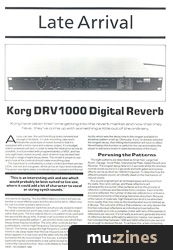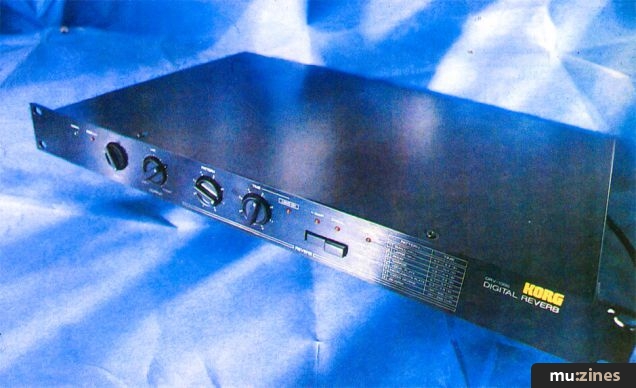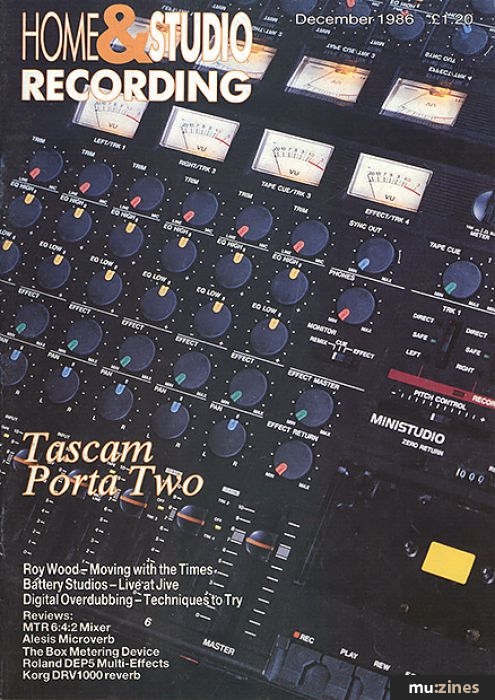Magazine Archive
Home -> Magazines -> Issues -> Articles in this issue -> View
Late Arrival | |
Korg DRV1000 Digital ReverbArticle from Home & Studio Recording, December 1986 | |
The DRV1000 heralds Korg's late entry into the digital reverb market, but has it come too late?
Korg have taken their time getting into the reverb market and now that they have, they've come up with something a little out of the ordinary.

As you can see, this unit from Korg looks conventional enough in its black, 1U rack-mounting case and it follows the usual style of reverb format in that it's equipped with a mono input and a stereo output. It's a budget, mains-powered unit and, in order to keep the retail price as low as possible, is not provided with programmability or MIDI, and has only eight basic reverb sounds, each of which may be switched through a range of eight decay times. The model is simple to use and a look at the controls should make everything clear.
The input level is controlled by a rotary control and there are two LEDs, one red and one green, which act as an input level indicator. The green one lights when a moderate input is present and the red one warns of clipping. The dry/effect balance control will also be familiar to most effects users and this should be set to 'effect only' for use in a mixer auxiliary send circuit.
The two reverb selector switches are physically styled to match the other controls but are 8-way rotary switches with click stops rather than pots. The first selects the reverb pattern to be used and the second the decay time. A small chart is printed on the front panel which gives the pattern types and the limits over which their decay times may be modified. The only other controls are two pushbuttons: one for High Frequency Damping and one for Cancel. The former causes the high frequency content of the reverb to die away faster than the low frequencies to help simulate what happens in a real room and the latter kills the effect sound but leaves the dry sound intact. For live use, a simple footswitch (optional) may be connected to a rear panel socket to remotely control the Cancel function. Also controllable by footswitch is a facility which sets the decay time to the longest available for whatever pattern is set up. Obviously, if you've already selected the longest decay, then hitting the footswitch will have no effect. Nevertheless this function is useful for live use and enables the player to add extra reverb to selected sections of the music.
Perusing the Patterns
The eight patterns are described as Small Hall, Large Hall, Room, Garage, Vocal Plate, Instrumental Plate, Gated Reverb and Reverse. The longest decay time is 5.2 seconds whilst the shortest normal reverb sound is 0.2 seconds and both gated and reverse effects can be as short as 150mS if required. To describe how the different presets sound, let's briefly dwell on the mechanism of natural reverb.
Any sound originating in an enclosed space will bounce from the walls, floor and ceilings, and these reflections will subsequently encounter other surfaces and so the process of reflection continues and becomes more complex. Each time the sound is reflected, the number of discrete reflections or echoes is increased and some of the energy becomes absorbed. Because of the nature of materials, high frequencies tend to be absorbed more readily than low ones so the reverberated sound mellows as it decays. The outcome of this is that a listener can only discern the first few individual reflections as individual echoes before the sound builds up to into a complex clutter with tens of thousands of reflections per second. It's not really practical to generate this kind of reflection density artificially by electronic means, but research has indicated that between 1000 and 3000 reflections per second are enough to deceive the ear. To achieve this, a fast computing system is needed and the design of reverb software is a closely guarded secret, as it has a profound result on the authenticity of the simulation. A problem when designing a budget reverb is that some compromise has to made unless you take a completely unconventional design approach or save money in other areas such as packaging. Another problem the designers face is that digital reverb can sound very rough unless the analogue to digital converters are at least 12-bit and preferably 16. The bandwidth, however is well up to scratch at 20Hz to 20kHz.
"This is an interesting unit and one which would probably be best suited to live use, where it could add a lot of character to vocal or string synth sounds."
Appraising the Ambience
The classic way to test a reverb is to feed it with a short impulse such as a click, a handclap or a snare drum sound from a drum machine. From this the listener can pick out the early reflections and appraise the density and smoothness of the decay. First impressions of the DRV1000 are that the sound is clean but not very dense. The effect is more like a multi-tapped delay than reverb, though this would probably not be so noticeable on a smoother sound such as vocals. This doesn't produce a very natural effect on drums though as the individual repeats are always audible, rather like a series of clicks or, as one person described it, the sound of tearing cloth. At a guess, I would be surprised if the reflection density generated by the DRV1000 was greater than 100 reflections per second which is far short of the actual requirement for a convincing emulation of the real thing.
The six conventional reverb settings are all perceptibly different but aren't really true to their names. In a blindfold test, I don't think anyone who hadn't previously used the unit would be able to tell (for example) which was Vocal Plate and which was Garage. Regardless of which setting was selected, the sound retained the granular coarseness that betrays low reverberation density; that's not to say that it makes the effect unusable. It would be fine for vocals or string-like keyboards, and live, the room acoustics would probably help to increase the diffusion to an acceptable level.
The gated sound is a different matter. This is an interesting effect but it doesn't really sound like gated reverb as we have come to expect it at all. Again, this is caused by low density and what you actually get seems to be a series of closely spaced echoes. If you can imagine a thimble being run across a washboard, it will give you an idea of their spacing. The same is true of the reverse setting which comprises a series of reflections which grow in amplitude before abruptly halting.
Something that emerged during the test was that the input metering is not a fair guide as to what signal levels will actually cause distortion. Although the input was set so as not to cause the red LED to light, some bright sounds caused audible distortion. A further reduction in level happily cured this. Another minor snag is that the muting which operates when changing patterns kills the reverb part of the output for two or three seconds which seems a bit on the long side. This could be particularly embarrassing when trying to do a quick reverb change mid-song but operating the 'long' switch causes no such problem.
"First impressions of the DRV1000 are that the sound is clean but not very dense."
Concluding the Case
This is an interesting unit and one which would probably be best suited to live use, where it could add a lot of character to vocal or string synth sounds. However, I couldn't put my hand on my heart and recommend it for percussion or serious recording, especially when you consider the alternatives in the same price range. Two years ago, this product would have been very exciting, but after evaluating some of the current competition, I must conclude that Korg have missed the boat on this one.
This is altogether rather surprising because Korg have a reputation for manufacturing products that are good value, innovative and above all, professional sounding. It may be that this was a hurried attempt to get a product into the budget end of the reverb market before it became too crowded, the price is certainly right. It is very likely, given Korg's undisputed technical expertise, that any subsequent model will be a much more serious proposition.
The DRV1000 costs £333 including VAT.
Further information can be obtained from: Rose Morris, (Contact Details).
Also featuring gear in this article
Hot Stuff - Korg DRV-1000 Digital Reverb
(SOS Dec 86)
Korg DRV 1000 Digital Reverb
(MM Dec 86)
Korg DRV1000 Digital Reverb
(MT Jan 87)
Browse category: Studio/Rack FX > Korg
Publisher: Home & Studio Recording - Music Maker Publications (UK), Future Publishing.
The current copyright owner/s of this content may differ from the originally published copyright notice.
More details on copyright ownership...
Review by Paul White
Help Support The Things You Love
mu:zines is the result of thousands of hours of effort, and will require many thousands more going forward to reach our goals of getting all this content online.
If you value this resource, you can support this project - it really helps!
Donations for May 2024
Issues donated this month: 0
New issues that have been donated or scanned for us this month.
Funds donated this month: £0.00
All donations and support are gratefully appreciated - thank you.
Magazines Needed - Can You Help?
Do you have any of these magazine issues?
If so, and you can donate, lend or scan them to help complete our archive, please get in touch via the Contribute page - thanks!







